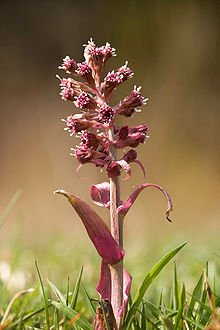- Common Butterbur
-
Petasites hybridus 
Common Butterbur Scientific classification Kingdom: Plantae (unranked): Angiosperms (unranked): Eudicots (unranked): Asterids Order: Asterales Family: Asteraceae Tribe: Senecioneae Genus: Petasites Species: P. hybridus Binomial name Petasites hybridus
(L.) G.Gaertn., B.Mey. & Scherb.Synonyms Petasites vulgaris
Common Butterbur (Petasites hybridus) is a herbaceous perennial plant in the family Asteraceae, native to Europe and northern Asia. The flowers are produced in the early spring, before the leaves appear; they are pale pink, with several inflorescences clustered on a 5-20 cm stem. The leaves are large, on stout 80-120 cm tall stems, round, with a diameter of 40-70 cm.
It is also called Bog rhubarb, Devil's hat and Pestilence wort. Synonyms include P. officinalis, P. ovatus and P. vulgaris.
Contents
Herbalism
The herbalist Nicholas Culpeper called it "a great preserver of the heart and reviver of the spirits". Its many uses in folk medicine include applications as a diuretic and muscle relaxant, and to treat coughs, fever, wounds, stammering, headaches, asthma and stress. Not all of these uses are supported by scientific research.
Medicinal Uses
Some trials have shown a preparation of Butterbur root to be effective in reducing the frequency and severity of migraine attacks.[1] A commercial extract Petasol butenoate complex (Ze 339) has proved helpful for allergic rhinitis[2][3] An evidence-based 2005 systematic review including written and statistical analysis of scientific literature, expert opinion, folkloric precedent, history, pharmacology, kinetics/dynamics, interactions, adverse effects, toxicology, and dosing is available from the Natural Standard Research Collaboration.[4]
Further reading
- Howard, Michael. traditional folk Remedies (Century, 1987) P. 111.

This Senecioneae-related article is a stub. You can help Wikipedia by expanding it.





